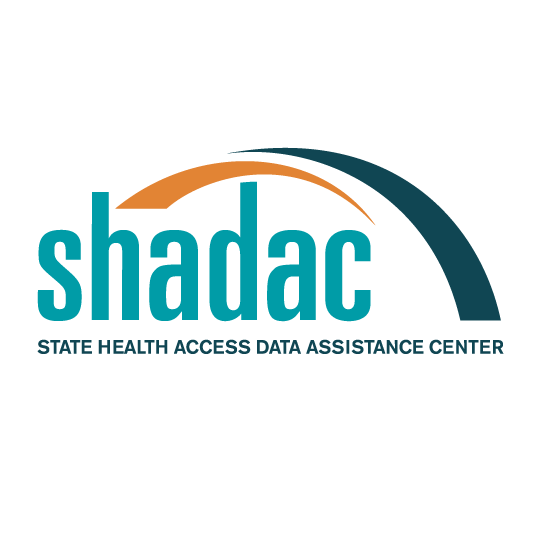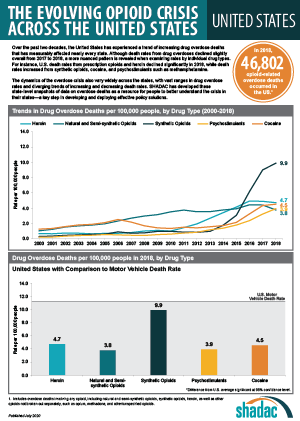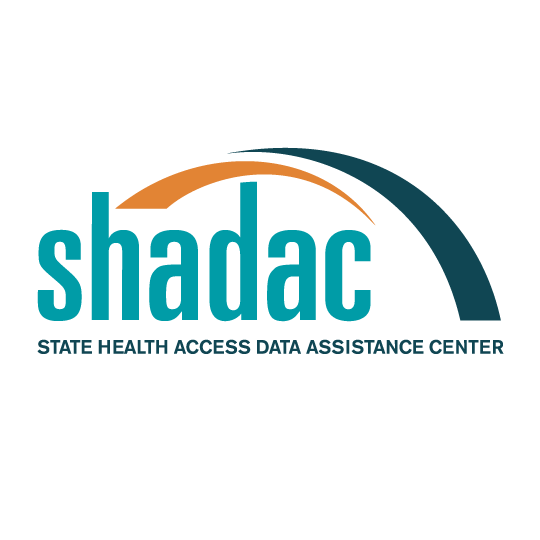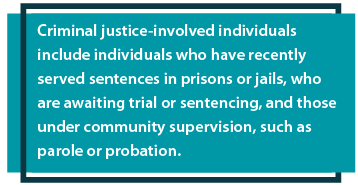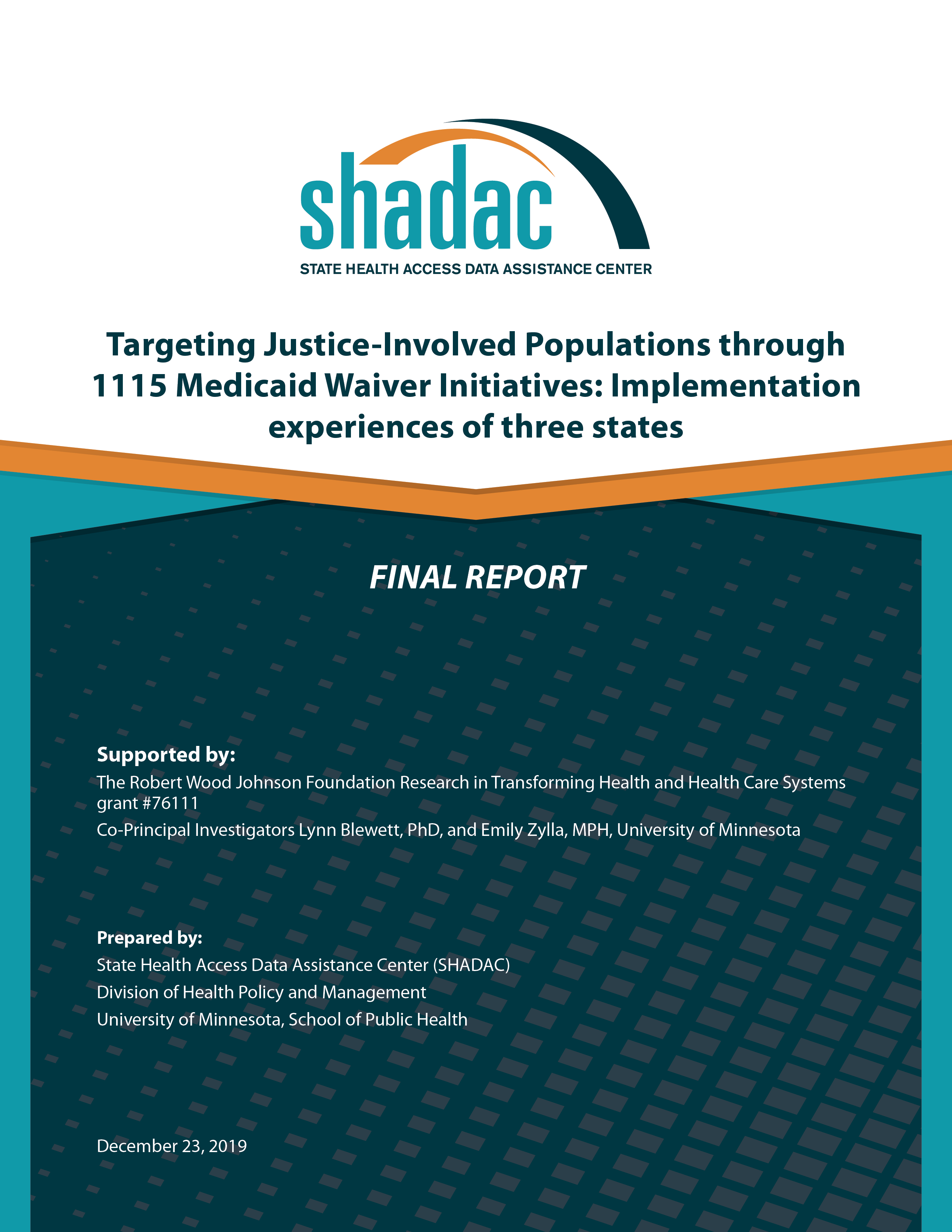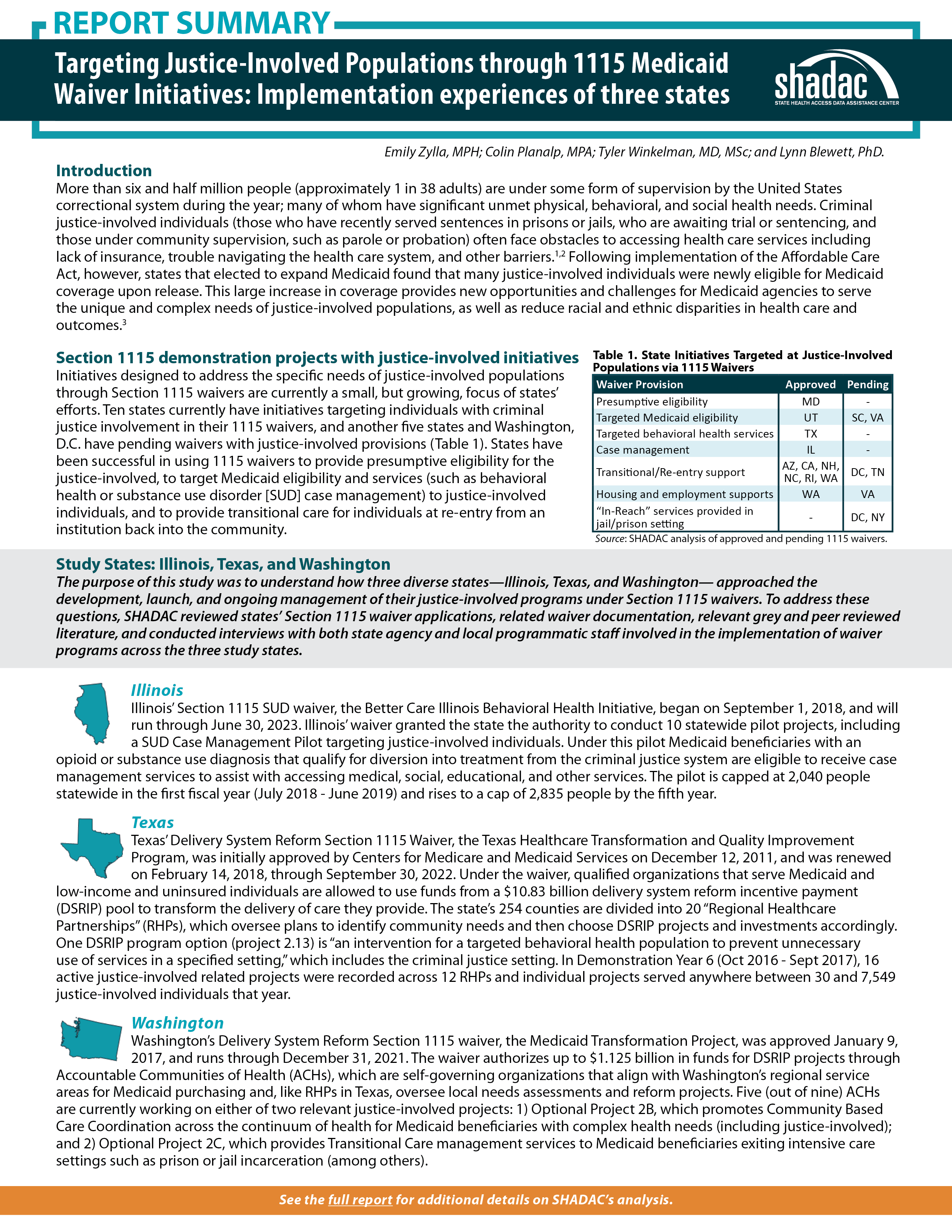Publication
50-State Analysis of Drug Overdose Trends: The Evolving Opioid Crisis Across the States (Infographics)
This set of two-page infographics uses estimates from SHADAC’s State Health Compare online data tool to explore the evolving opioid overdose epidemic across all 50 states and the District of Columbia, examining state variation in both the prevalence of opioid deaths and the types of opioids associated with these deaths. Additionally, due to growing concern and evidence that the opioid crisis may be expanding to other non-opioid illicit drugs, we have included data on drug overdose deaths from two types of drugs that are commonly involved in opioid overdoses: cocaine and psychostimulants, such as methamphetamine.
The infographics highlight key findings for trends in drug overdose deaths from 2000-2018, show how each state's overdose rates compare to the national average, and provide a high-level comparison of all 50 states' overdose death rates broken down by each of the five drug types.
Click on a state below to see its two-page infographic or download all state's infographics here.
Explore the drug overdose death data further on State Health Compare.
Further Reading and Resources
The Opioid Epidemic in the United States
SHADAC Resource, March 2020 (Updated)
The Evolving Opioid Epidemic: Observing the Changes in the Opioid Crisis through State-level Data
SHADAC Webinar, September 2019
The Opioid Epidemic: National and State Trends in Opioid-Related Overdose Deaths from 2000 to 2017
SHADAC Briefs, June 2019
Archive: 2000-2017 Evolving Opioid Crisis Infographics
SHADAC Infographics, February 2019
Blog & News
An Updated Brief Examines State Health Compare Estimates on State Funding for Public Health
May 13, 2020: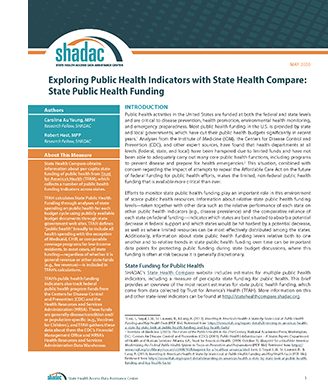 As states have urgently strategized responses to the sudden arrival of the initial wave of the coronavirus pandemic and begun to prepare for the possibility of a second wave in the fall, states’ per-capita public health funding is a metric that has garnered new attention. Estimates for this measure not only reveal a state’s prioritization of investment in public health infrastructure, but also levels of preparedness for health emergencies such as COVID-19. With this understanding, a number of media outlets have used the public health spending rankings chart provided by SHADAC’s State Health Compare to publish articles which highlight the challenges that states on the lower end of the public health spending spectrum now face in attempting to respond to the COVID-19 crisis.
As states have urgently strategized responses to the sudden arrival of the initial wave of the coronavirus pandemic and begun to prepare for the possibility of a second wave in the fall, states’ per-capita public health funding is a metric that has garnered new attention. Estimates for this measure not only reveal a state’s prioritization of investment in public health infrastructure, but also levels of preparedness for health emergencies such as COVID-19. With this understanding, a number of media outlets have used the public health spending rankings chart provided by SHADAC’s State Health Compare to publish articles which highlight the challenges that states on the lower end of the public health spending spectrum now face in attempting to respond to the COVID-19 crisis.
In light of this information, and with the release of the latest estimates for public health spending for 2019, SHADAC has just recently updated our brief on estimates of state-provided funding for the State Health Compare measure, “Public Health Funding.” Though this updated brief highlights state public health funding data from 2015–2019, data is available on the State Health Compare website for every year, starting in 2005 (with the exception of data year 2006 for which no estimates are available).
The Big Picture: Wide Variation between States
There is a wide gap between state public health funding among states, with 2019 state-provided funding ranging from $7 per capita in Missouri to $363 per capita in the District of Columbia (D.C.). In 2019, the median state, Kentucky spent $35 per capita in public health funding.
Per Person Public Health Funding, 2019
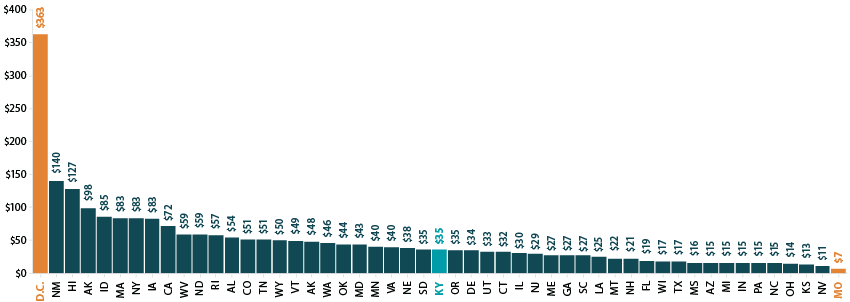
Top States for State Public Health Funding
Eight states occupied the top five funding spots over the course of five years, from 2015 through 2019 (the most recent five years for which data are available): Alaska, D.C., Hawaii, Idaho, New Mexico, New York, North Dakota, and West Virginia. Alaska, D.C., and Hawaii were among the top five states for each of the five years. In 2019, the top five states for per-capita state public health funding were Alaska, D.C., Hawaii, Idaho, and New Mexico.
Bottom States for Public Health Funding
Eight states also occupied the bottom five funding spots at various times over the five-year period (2015 through 2019). Arizona, Indiana, Kansas, Mississippi, Missouri, Nevada, North Carolina, and Ohio moved among the bottom five positions for state-provided public health funding during this time period. Both Missouri and Nevada consistently ranked among the bottom five states for each year of this period. In 2019, the bottom five states with regard to public health spending were: Kansas, Missouri, Nevada, North Carolina, and Ohio.
About the Estimates
Estimates of state funding for public health come from data collected by Trust for America's Health (TFAH), which obtains its calculations using budget documents that are publicly available through state government websites. Depending on which information is available, TFAH uses executive budget documents listing actual expenditures, estimated expenditures, or final appropriates; appropriations bills enacted by the state's legislature; and documents from legislative analysis offices to calculate public health spending. TFAH defines "public health" broadly to include most state-level health funding with the exception of Medicaid, CHIP, or comparable health coverage programs. SHADAC standardizes these estimates of state public health funding to the estimated population of each state to create per-capita estimates.
Why the Variation among States on this Measure?
According to Trust for America's Health, comparisons of public health funding levels across states are difficult because every state allocates and reports its budget in different ways, and states vary widely in the budget details they provide. Non-methodological sources of inter-state variation in state public health funding may also include the relative performance of individual state economies (since state public health funding is often cut during economic downturns) as well as the relative tax bases of individual states along with state population counts.
Explore Additional Public Health Data at State Health Compare
Visit State Health Compare to explore national and state-level estimates for the following public health indicators:
- Weight Assessment in Schools
- School Nutrition Standards Stronger than USDA
- School Required to Provide Physical Activity
- Smoke Free Campuses
- Cigarette Tax Rates
State Health Compare also features a number of other indicator categories, including: health insurance coverage, cost of care, access to and utilization of care, care quality, health behaviors, health outcomes, and social determinants of health.
Publication
Targeting Justice-Involved Populations through 1115 Medicaid Waiver Initiatives: Implementation experiences of three states
New SHADAC Report on States Serving Justice-Involved Populations through Section 1115 Waivers
Under a Research in Transforming Health and Health Care Systems grant from the Robert Wood Johnson Foundation, SHADAC recently conducted a study of the ways in which states are using Section 1115 transformation waivers to test new approaches to serving individuals with criminal justice involvement.1
While each of the three states included in SHADAC’s study (Illinois, Texas, and Washington), faced unique financial, political, and economic dynamics when designing their respective 1115 waivers, states reported several similar factors that drove decisions to include justice-involved initiatives:
1) finding innovative ways to address the opioid crisis; 2) recognition of the justice-involved as a high-need, vulnerable population on which smaller scale initiatives could be piloted; and 3) recognition of justice-involved individuals as an important target for efforts to better integrate primary care and behavioral health.
About the Study
Ten states currently have initiatives targeting individuals with criminal justice involvement in their 1115 waivers, and another five states and Washington, D.C. have pending waivers with justice-involved provisions. States have been successful in using 1115 waivers to provide presumptive eligibility for the justice-involved, to target Medicaid eligibility and services to justice-involved individuals, and to provide transitional care for individuals at re-entry from an institution back into the community.
SHADAC’s study sought to understand how three diverse states—Illinois, Texas, and Washington— approached the development, launch, and ongoing management of their justice-involved programs under Section 1115 waivers. To address these questions, SHADAC reviewed states’ Section 1115 waiver applications, related waiver documentation, relevant grey and peer reviewed literature, and conducted interviews with both state agency and local programmatic staff involved in the implementation of waiver programs across the study states.
Key Report Themes
Interview responses across the three states revealed several key themes as they related to common facilitators and challenges during the waiver implementation process, as well as pros and cons of the waiver itself as a mechanism for transformation.
Successful implementation of justice-involved initiatives in all three study states involved:
- Significant coordination among multiple stakeholders, especially law enforcements
- Drawing on stakeholders’ previous experience with justice-involved grants
- Leveraging existing infrastructure
Stakeholders also reported many similar barriers and challenges in carrying out their work, including:
- Aligning goals of the multiple sectors that interact with justice-involved populations
- Placing culturally competent program staff in criminal justice settings
- Addressing privacy and security concerns related to sharing data among various sectors, and also capabilities of partners to perform data analysis that could prove the value of the work
Some individuals were especially hopeful that investing waiver resources in new infrastructure would help identify and reduce health disparities that have long existed in this population. Stakeholders also felt that 1115 waiver forced their partners to be more collaborative,
The small size of the target population meant that specific justice-involved issues were not necessarily at the forefront of waiver discussions and community partners felt that required waiver reporting was administratively complex and burdensome. Stakeholders also expressed concerns that waiver reimbursement methods and corresponding evaluation metrics wouldn’t adequately reflect the success of a justice-involved initiative.
However, they ultimately felt that efforts to undertake such programs were worthwhile because the waiver expanded access to services that would not otherwise be available to a high-need population.
Looking to the Future
Ensuring the sustainability of any justice-involved initiative implemented under a state’s 1115 waiver was a major focus of all the stakeholders. Stakeholders advocated bringing together multiple parties early and often to discuss sustainability of the project after the waiver ends—including structuring a supportive staffing model, collecting needed data to conduct return-on-investment analyses, securing the participation of other payers, and setting up an adequate reimbursement structure and value-based payment bundles reflective of population needs.
The experiences of stakeholders in Illinois, Texas, and Washington can be helpful to other states as they consider whether to implement programs aimed at individuals involved in the criminal justice system via Section 1115 Medicaid waivers.
[1] Criminal justice-involved individuals include individuals who have recently served sentences in prisons or jails, who are awaiting trial or sentencing, and those under community supervision, such as parole or probation.
SHADAC Expertise
Medicaid and CHIP Policy
SHADAC has worked both independently and under contract to the Robert Wood Johnson Foundation (RWJF) and the Medicaid and CHIP Payment Access Commission (MACPAC) to monitor and analyze changes in the Medicaid and CHIP policy landscape such as Medicaid expansion, eligibility, enrollment, and renewal, quality measurement, as well as states’ waiver application, implementation, and evaluation. SHADAC faculty and staff have exceptional knowledge of Medicaid and CHIP, including knowledge from the perspective of state policymakers and program administrators, as well as operational issues at the federal and state levels.
Related SHADAC work
Click on any title below to learn more about the project.
Tracking the Data on Medicaid’s Continuous Coverage Unwinding (State Health & Value Strategies)
A lack of publicly available data on Medicaid enrollment, renewal, and disenrollment makes it difficult to understand exactly who is losing Medicaid coverage and for what reasons. This issue brief lays out a phased set of priority measures and provides a model enrollment and retention dashboard template that states can use to monitor both the short-term impacts of phasing out public health emergency (PHE) protections and continuous coverage requirements, as well as longer-term enrollment and retention trends. Through its work with SHVS, SHADAC also published a series of issue briefs that tracked through an interactive map the format of state reporting of unwinding data, state-based marketplace transition data (i.e. people who no longer qualify for Medicaid but might be eligible for a qualified health plan offered through the marketplace), and Medicaid unwinding reinstatement data.
Supporting BDT’s Stabilizing Medicaid Enrollment Learning Collaborative
SHADAC collaborated with a new partner, Benefits Data Trust (BDT), on a small project to design and lead a webinar for its Medicaid Churn Learning Collaborative participants on the topic of monitoring and evaluation. The webinar took place as state Medicaid agency participants were implementing activities to redetermine all individuals enrolled in Medicaid and were meeting federal reporting requirements to monitor the end of the continuous coverage provisions.
Tracking Health Insurance Coverage During the Unwinding: Monthly Data from the Household Pulse Survey
The unwinding of the Medicaid continuous coverage requirement ("Medicaid Unwinding") represents the largest nationwide coverage transition since the Affordable Care Act. Since February 2020, enrollment in Medicaid and the Children’s Health Insurance Program (CHIP) has increased by 23 million enrollees. Not only that, but analysis also indicates that as many as 15 million individuals will exit Medicaid to other coverage or become uninsured. Lack of publicly available data on Medicaid enrollment, renewal, and disenrollment makes it difficult to track the phenomenon of the 'Medicaid Unwinding'. As states “unwind” the Medicaid continuous coverage requirement and restart standard redetermination procedures, SHADAC researchers are using data from the U.S. Census Bureau’s Household Pulse Survey (HPS) to track trends in health insurance coverage rates. See our findings and frequent updates here.
Past Work
Assessment and Synthesis of Selected Medicaid Eligibility, Enrollment, and Renewal Processes and Systems in Six States
SHADAC worked as a contractor for the Medicaid and CHIP Payment Access Commission (MACPAC) to conduct an assessment of Medicaid eligibility, enrollment, and renewal processes and systems in six study states—Arizona, Colorado, Florida, Idaho, New York, and North Carolina. Utilizing a multi-case study methodology as well as key informant interviews with state and local agency staff and advocacy organizations, SHADAC collected and synthesized data on Medicaid enrollment processes and systems for individuals whose income eligibility is based on Modified Adjusted Gross Income (MAGI) in order to assess the extent to which states were achieving desired goals such as program efficiency and a simplified beneficiary experience. As a follow up, SHADAC identified the risks that remain for both individuals and state agencies that cause eligible individuals to remain uninsured or lose Medicaid coverage and conducted interviews with key stakeholders nationally and in four states to obtain additional input on potential risk points and strategies to improve eligibility determination and renewal accuracy.
SHADAC Advocates a Data-based Approach to Advancing Medicaid and CHIP Access Monitoring Plan
On February 17, 2022, the Centers for Medicare & Medicaid Services (CMS) released a request for information (RFI) regarding access to coverage and care in Medicaid and the Children’s Health Insurance Program (CHIP). SHADAC researchers focused our response on Objective 4: Question 1, which asked researchers to consider how CMS might develop a stronger Medicaid and CHIP access monitoring approach through data reporting and analysis. These comments are based on SHADAC’s experience providing data and evaluation technical assistance (TA) to states, and mirror recent testimony to the Medicaid and CHIP Payment Access Commission (MACPAC) provided by SHADAC’s Deputy Director.
Addressing Social Determinants of Health through Behavioral Health-focused 1115 Waivers: Implementation Lessons from Three States
Through the Robert Wood Johnson Foundation’s (RWJF) “Research in Transforming Health” program, SHADAC researchers conducted a study to understand how three states—Illinois, Texas, and Washington—were addressing the needs of justice-involved populations through implementation of Section 1115 Medicaid waiver programs. The specific aim of the study was to identify promising practices and lessons learned related to the development, implementation, and management of these innovative behavioral health policies with the purpose of informing policy development in states considering similar 1115 waivers.
SHADAC Expertise
State and Federal Health Policy and Strategies
Our faculty and staff are nationally recognized experts on collecting and applying sound data to inform public health, health care reform strategies, federal healthcare policy, and health policy decisions at both the state and federal levels. We rely on both qualitative and quantitative data sources to identify and frame policy options and bring long-standing qualifications in tapping federal survey data sources. We provide direct technical assistance to individual states, create forums to support state-to-state peer learning, and more broadly conduct targeted research and policy analysis as well as translate technical information into content that is accessible and informative to decision-makers.
Related SHADAC work:
Click on any title below to learn more about the project.
State Health & Value Strategies Technical Assistance
SHADAC provides technical assistance as part of the Robert Wood Johnson Foundation’s (RWJF's) State Health & Value Strategies (SHVS), a program that connects state officials with experts in the field to support them in transforming their health care systems to be affordable, equitable, and innovative. SHADAC provides analytic and evaluation support with the goal of helping states use sound data to inform policy decisions on topics such as Medicaid, state health policy, federal healthcare policy, health equity, multi-payer delivery system and payment reform, quality measurement, coverage and access expansions, health insurance exchanges, and population health. Recent work has focused on the unwinding of the Medicaid continuous coverage requirement, where SHADAC has worked closely with several states to model the enrollment impacts of unwinding. Another ongoing area of support is helping state agencies improve the quality and collection of enrollee demographic data (e.g. race, ethnicity, language, disability, sexual orientation and gender identity) with a goal of improved health equity programming. This is done both by working with states one-on-one, but also through a peer-learning group aimed at discussing specific operational challenges related to data collection, coding and analysis.
State-Based Reinsurance Programs via 1332 State Innovation Waivers
SHADAC maintains a frequently updated resource highlighting state reinsurance policies passed using a 1332 waiver. This information is presented in an interactive map that provides an overview of the different stages of states' 1332 waiver reinsurance applications.
Public Health Implications of Cannabis Policy in Minnesota
SHADAC and the University of Minnesota’s Cannabis Research Center (CRC) have released a brief using data from the National Survey on Drug Use and Health (NSDUH) to understand issues related to public health implications of Minnesota cannabis use prior to its 2023 legalization. Along with providing key background information and context on cannabis policy in the United States, this brief specifically examines three oft cited concerns with cannabis legalization: the prevalence of cannabis use; cannabis abuse and dependence (i.e., addiction); and driving under the influence of cannabis. The data in this brief are intended to serve as starting points for discussions on the public health impacts of Minnesota cannabis policy. Read the brief in full here along with this accompanying blog post.
Minnesota Long-Term Services and Supports: Demographics Report, Future Utilization & Payments, Projection Model
Lynn Blewett, founding Director of SHADAC, worked alongside researchers at Purdue University to author a report on utilization, cost, and demographics of populations that use Long-Term Services and Supports (LTSS) in Minnesota. This was conducted as part of a larger study, Own Your Future 3.0: Planning for Minnesotans’ LTSS Needs, sponsored by Minnesota’s Department of Human Services, Aging and Adult Services Division. SHADAC researchers and collaborators on this project worked towards the objectives of studying current and future use of Long-Term Services and Supports (LTSS) for older Medicaid enrollees and the general older population in Minnesota, describing LTSS service utilization and expenditures for Minnesota’s older population in 2016-2021, and estimating future Medicaid LTSS utilization and expenditures using demographic data, areas of need, and other information. SHADAC has also collaborated with the Minnesota Department of Human Services to develop a model estimating future Medicaid utilization and spending in Minnesota for long-term services and supports (LTSS). The spreadsheet model leveraged data from the American Community Survey (ACS), the state’s Medicaid Management Information System (MMIS), and the state’s Survey of Older Minnesotans to define current Medicaid cohorts and use, calculate projections of future eligibility, and delineate predictors of LTSS service use under different economic and policy assumptions.
Past Work
Leveraging 1332 State Innovation Waivers to Stabilize Individual Health Insurance Markets
Funded by the Robert Wood Johnson Foundation (RWJF), SHADAC researchers documented the strategies and rationale of the first three states to receive federal approval to establish state reinsurance programs with federal funding—Alaska, Minnesota, and Oregon—via Section 1332 State Innovation Waivers in order to address the volatility of their individual health insurance markets. SHADAC identified challenges, facilitators, and lessons learned during the waiver application and implementation processes that could be helpful for states considering similar state health policy action and for federal regulators interested in supporting similar state initiatives.
Strategies to Increase Access to Medications for Opioid Use Disorder during the COVID-19 Pandemic and Beyond
SHADAC researchers, along with Hennepin Healthcare researcher Tyler Winkelman, authored a Milbank Foundation policy brief that examines the federal healthcare policy and state policy changes put in place to improve access to medications for opioid use disorder (MOUD) during the COVID-19 pandemic, during which time MOUD became especially challenging to access because MOUD patients are typically required to have as many as six in-person clinic visits a week. The authors conclude with federal and state policy recommendations based on their analysis.
Assessment of State Health Information Exchange Policy
On behalf of the Connecticut Health Foundation, SHADAC authored a policy brief exploring the launch of a new statewide health information exchange (HIE)—the Health Information Alliance— in Connecticut. In addition to providing context for the state’s new HIE, the brief also offers an overview of the current landscape in Connecticut related to information exchange and describes opportunities and potential obstacles going forward, such as the need for robust provider participation, provision of incentives to ensure participation, and the development of a long-term funding and patient engagement strategy. To inform this work, SHADAC researchers conducted a review of select national and state literature and organized interviews with key stakeholders both in Connecticut and in other states that are further along with statewide HIE efforts, with the goal of helping policymakers and those interested in patient care and population health understand where the state is today, what’s coming, and what to consider for success.



